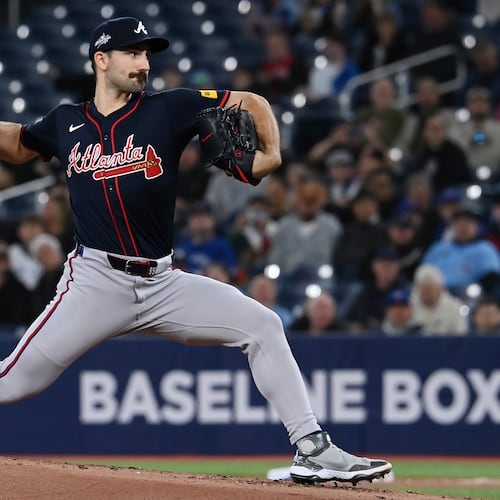When the Braves disclosed that they topped a half-billion dollars in revenue and $100 million in profit last year, many fans called for a significant boost in the player payroll.
That is happening, although not in the way Braves Country may have envisioned.
Despite not re-signing franchise icon Freddie Freeman, now the Los Angeles Dodgers’ first baseman, the Braves committed $212 million to four players last week, including $44 million in 2022 salaries.
The spending spree on trade acquisition Matt Olson and free agents Kenley Jansen, Eddie Rosario and Collin McHugh put the Braves’ projected opening-day payroll at approximately $173 million, pending further transactions, according to calculations by The Atlanta Journal-Constitution.
That’s up 33% from $130 million at the start of last season and up 17% from $148 million at the end of last season. It’s the highest payroll in franchise history and likely will rise higher with additional moves before or during the season.
The bulk of the Braves’ new spending came in an eight-year, $168 million contract with first baseman Olson, Freeman’s replacement, signed on the day after he was acquired from Oakland for four prospects. Although Olson’s contract is the largest in Braves history in total value, his 2022 salary ($15 million) and average annual salary ($21 million) are less than the Braves paid Freeman last year, so the contract alone didn’t take the organization into new financial ground.
Instead, it was the signing of relief pitcher Jansen to a one-year, $16 million contract that brought into sharp focus the Braves’ loosened purse strings.
The Braves signed Jansen, formerly of the Dodgers, despite already having a stellar bullpen that starred in last year’s postseason run to the World Series championship. Notably, the addition of Jansen came one year after the Braves chose for financial reasons not to re-sign 2020 closer Mark Melancon.
“I know it’s been talked about ad nauseam, but we cut payroll (in 2021),” Braves president of baseball operations Alex Anthopoulos said on a late-Friday Zoom call after signing Jansen. (Amid COVID-19 uncertainties, the Braves reduced last year’s opening-day payroll to $130 million from what would have been about $151 million in 2020 before the pandemic shortened the season and prorated salaries.)
“We had to make tough decisions, letting (reliever) Darren O’Day go, letting Melancon go, and it burned us,” Anthopoulos said. “We got through it, thank God, and we won the whole thing. But that depth is important, especially in the bullpen.”
It can be expensive, too. Two of the Braves’ six highest-paid players this year are relievers: Jansen and, at $13 million, Will Smith.
In addition to Olson and Jansen, the Braves’ other major expenditures last week were re-signing outfielder Rosario as a free agent to a two-year, $18 million contract ($9 million this year) and signing reliever McHugh to a two-year, $10 million contract ($4 million this year).
With the new spending, the Braves at the moment rank eighth among the 30 MLB teams in payroll, up from 13th at the end of last season. The teams with MLB’s two highest payrolls are in the National League: the Dodgers (currently projected at about $275 million) and the New York Mets ($260 million).
The Braves currently rank third among the five NL East teams in payroll, behind the Mets and the Philadelphia Phillies. Both of those teams have had spending sprees of their own.
The Phillies, who finished second in the division last season, 6 ½ games behind the Braves, spent $179 million to add two free-agent sluggers last week: Nick Castellanos (five years, $100 million) and Kyle Schwarber (four years, $79 million). The Mets, who finished 11 ½ games behind the Braves last year, spent $254.5 million in November on four free agents: pitcher Max Scherzer (three years, $130 million), outfielders Starling Marte (four years, $78 million) and Mark Canha (two years, $26.5 million) and infielder Eduardo Escobar (two years, $20 million).
It is worth noting that there are different methods for calculating team payrolls, which explains why different sources will offer different figures. Payrolls for luxury-tax purposes, for example, are higher because they include the full 40-man roster, the average annual value of long-term contracts (rather than the current year’s salary) and the team’s cost for benefits such as pension and insurance. The Braves remain well below MLB’s luxury-tax threshold of $230 million.
The AJC’s payroll calculations are based on the 2022 salaries of players projected to open the season on the 26-man roster and the injured list. Salaries are estimated for arbitration-eligible players whose 2022 pay hasn’t been set yet.
The Braves’ payroll increase follows a dramatic improvement in key business metrics last year. Braves Holdings brought in $568 million in revenue, up from a previous franchise high of $476 million in pre-pandemic 2019, and had an operating profit before depreciation and amortization of $111 million, according to figures released by team owner Liberty Media.
The AJC reported last month that if the Braves’ 2022 major-league player payroll turned out to be the same percentage of 2021 revenue as the original 2020 payroll would have been of 2019 revenue, that would mean a $180 million payroll this year. The Braves are well on their way to that level and, with further moves inevitable over the course of a long season, may exceed it.
Credit: TNS
Credit: TNS
TOPPING THE PAYROLL
The five highest-paid Braves in 2022, two of whom were acquired last week:
Charlie Morton, SP: $20 million
Kenley Jansen, RP: $16 million
Marcell Ozuna, DH-OF: $16 million
Ronald Acuna, OF: $15 million
Matt Olson, 1B: $15 million
About the Author
Keep Reading
The Latest
Featured




